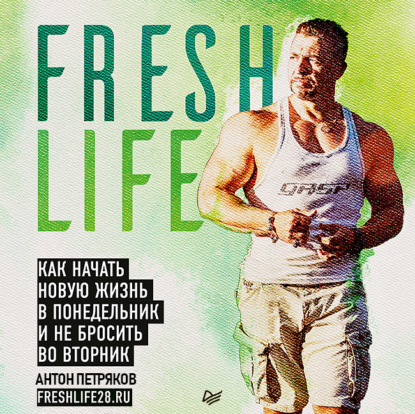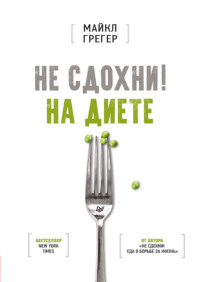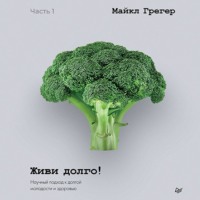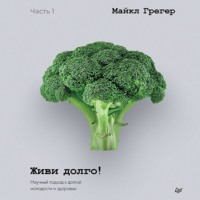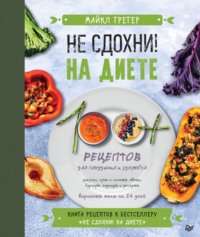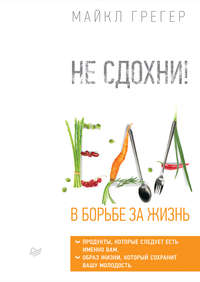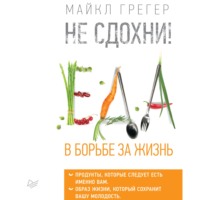
Полная версия
Живи долго! Научный подход к долгой молодости и здоровью
2686
Martins LB, Rodrigues AMdS, Monteze NM, et al. Double-blind placebo-controlled randomized clinical trial of ginger (Zingiber officinale Rosc.) in the prophylactic treatment of migraine. Cephalalgia. 2020;40(1):88–95. https://pubmed.ncbi.nlm.nih.gov/29768938/
2687
Chen L, Cai Z. The efficacy of ginger for the treatment of migraine: a meta-analysis of randomized controlled studies. Am J Emerg Med. 2021;46:567–71. https://pubmed.ncbi.nlm.nih.gov/33293189/
2688
Pourmasoumi M, Hadi A, Rafie N, Najafgholizadeh A, Mohammadi H, Rouhani MH. The effect of ginger supplementation on lipid profile: a systematic review and meta-analysis of clinical trials. Phytomedicine. 2018;43:28–36. https://pubmed.ncbi.nlm.nih.gov/29747751/
2689
Makhdoomi Arzati M, Mohammadzadeh Honarvar N, Saedisomeolia A, et al. The effects of ginger on fasting blood sugar, hemoglobin A1c, and lipid profiles in patients with type 2 diabetes. Int J Endocrinol Metab. 2017;15(4):e57927. https://pubmed.ncbi.nlm.nih.gov/29344037/
2690
Hasani H, Arab A, Hadi A, Pourmasoumi M, Ghavami A, Miraghajani M. Does ginger supplementation lower blood pressure? A systematic review and meta-analysis of clinical trials. Phytother Res. 2019;33(6):1639–47. https://pubmed.ncbi.nlm.nih.gov/30972845/
2691
Maharlouei N, Tabrizi R, Lankarani KB, et al. The effects of ginger intake on weight loss and metabolic profiles among overweight and obese subjects: a systematic review and meta-analysis of randomized controlled trials. Crit Rev Food Sci Nutr. 2018:1–14.; https://pubmed.ncbi.nlm.nih.gov/29393665/
2692
Morvaridzadeh M, Sadeghi E, Agah S, et al. Effect of ginger (Zingiber officinale) supplementation on oxidative stress parameters: a systematic review and meta-analysis. J Food Biochem. 2021;45(2):e13612. https://pubmed.ncbi.nlm.nih.gov/33458848/
2693
Mazidi M, Gao HK, Rezaie P, Ferns GA. The effect of ginger supplementation on serum C-reactive protein, lipid profile and glycaemia: a systematic review and meta-analysis. Food Nutr Res. 2016;60:32613. https://pubmed.ncbi.nlm.nih.gov/27806832/
2694
Choi JG, Kim SY, Jeong M, Oh MS. Pharmacotherapeutic potential of ginger and its compounds in age-related neurological disorders. Pharmacol Ther. 2018;182:56–69. https://pubmed.ncbi.nlm.nih.gov/28842272/
2695
Bischoff-Kont I, Fürst R. Benefits of ginger and its constituent 6-shogaol in inhibiting inflammatory processes. Pharmaceuticals (Basel). 2021;14(6):571. https://pubmed.ncbi.nlm.nih.gov/34203813/
2696
Teschke R, Xuan TD. Viewpoint: a contributory role of shell ginger (Alpinia zerumbet) for human longevity in Okinawa, Japan? Nutrients. 2018;10(2):166. https://pubmed.ncbi.nlm.nih.gov/29385084/
2697
Upadhyay A, Chompoo J, Taira N, Fukuta M, Tawata S. Significant longevity-extending effects of Alpinia zerumbet leaf extract on the life span of Caenorhabditis elegans. Biosci Biotechnol Biochem. 2013;77(2):217–23. https://pubmed.ncbi.nlm.nih.gov/23391900/
2698
Rasheed N. Ginger and its active constituents as therapeutic agents: recent perspectives with molecular evidences. Int J Health Sci (Qassim). 2020;14(6):1–3. https://pubmed.ncbi.nlm.nih.gov/33192225/
2699
Lee EB, Kim JH, Kim YJ, et al. Lifespan-extending property of 6-shogaol from Zingiber officinale Roscoe in Caenorhabditis elegans. Arch Pharm Res. 2018;41(7):743–52. https://pubmed.ncbi.nlm.nih.gov/29978428/
2700
Percival SS, Vanden Heuvel JP, Nieves CJ, Montero C, Migliaccio AJ, Meadors J. Bioavailability of herbs and spices in humans as determined by ex vivo inflammatory suppression and DNA strand breaks. J Am Coll Nutr. 2012;31(4):288–94. https://pubmed.ncbi.nlm.nih.gov/23378457/
2701
Stepien K, Wojdyla D, Nowak K, Molon M. Impact of curcumin on replicative and chronological aging in the Saccharomyces cerevisiae yeast. Biogerontology. 2020;21(1):109–23. https://pubmed.ncbi.nlm.nih.gov/31659616/
2702
Liao VHC, Yu CW, Chu YJ, Li WH, Hsieh YC, Wang TT. Curcumin-mediated lifespan extension in Caenorhabditis elegans. Mech Ageing Dev. 2011;132(10):480–7. https://pubmed.ncbi.nlm.nih.gov/21855561/
2703
Suckow BK, Suckow MA. Lifespan extension by the antioxidant curcumin in Drosophila melanogaster. Int J Biomed Sci. 2006;2(4):402–5. https://pubmed.ncbi.nlm.nih.gov/23675008/
2704
Kitani K, Osawa T, Yokozawa T. The effects of tetrahydrocurcumin and green tea polyphenol on the survival of male C57BL/6 mice. Biogerontology. 2007;8(5):567–73. https://pubmed.ncbi.nlm.nih.gov/17516143/
2705
Lao CD, Ruffin MT IV, Normolle D, et al. Dose escalation of a curcuminoid formulation. BMC Complement Altern Med. 2006;6:10. https://pubmed.ncbi.nlm.nih.gov/16545122/
2706
Bala K, Tripathy BC, Sharma D. Neuroprotective and anti-ageing effects of curcumin in aged rat brain regions. Biogerontology. 2006;7(2):81–9. https://pubmed.ncbi.nlm.nih.gov/16802111/
2707
Percival SS, Vanden Heuvel JP, Nieves CJ, Montero C, Migliaccio AJ, Meadors J. Bioavailability of herbs and spices in humans as determined by ex vivo inflammatory suppression and DNA strand breaks. J Am Coll Nutr. 2012;31(4):288–94. https://pubmed.ncbi.nlm.nih.gov/23378457/
2708
Percival SS, Vanden Heuvel JP, Nieves CJ, Montero C, Migliaccio AJ, Meadors J. Bioavailability of herbs and spices in humans as determined by ex vivo inflammatory suppression and DNA strand breaks. J Am Coll Nutr. 2012;31(4):288–94. https://pubmed.ncbi.nlm.nih.gov/23378457/
2709
DiSilvestro RA, Joseph E, Zhao S, Bomser J. Diverse effects of a low dose supplement of lipidated curcumin in healthy middle aged people. Nutr J. 2012;11:79. https://pubmed.ncbi.nlm.nih.gov/23013352/
2710
Rakha A, Rehman K, Babar Imran M, Shahid M, Jahan N. Mitigation of 131-I induced oxidative stress by supplementation of turmeric and green cardamom in thyroid patients. Int J Radiat Res. 2022;20(1):29–36. https://ijrr.com/article-1-4063-en.html
2711
Thorogood M, Appleby PN, Key TJ, Mann J. Relation between body mass index and mortality in an unusually slim cohort. J Epidemiol Community Health. 2003;57(2):130–3. https://pubmed.ncbi.nlm.nih.gov/12540689/
2712
Aune D, Sen A, Prasad M, et al. BMI and all cause mortality: systematic review and non-linear dose-response meta-analysis of 230 cohort studies with 3.74 million deaths among 30.3 million participants. BMJ. 2016;353:i2156. https://pubmed.ncbi.nlm.nih.gov/27146380/
2713
Willcox DC, Willcox BJ, Todoriki H, Curb JD, Suzuki M. Caloric restriction and human longevity: what can we learn from the Okinawans? Biogerontology. 2006;7(3):173–7. https://pubmed.ncbi.nlm.nih.gov/16810568/
2714
Willcox DC, Scapagnini G, Willcox BJ. Healthy aging diets other than the Mediterranean: a focus on the Okinawan diet. Mech Ageing Dev. 2014;136–7:148–62. https://pubmed.ncbi.nlm.nih.gov/24462788/
2715
Willcox BJ, Willcox DC, Todoriki H, et al. Caloric restriction, the traditional Okinawan diet, and healthy aging: the diet of the world’s longest-lived people and its potential impact on morbidity and life span. Ann N Y Acad Sci. 2007;1114:434–55. https://pubmed.ncbi.nlm.nih.gov/17986602/
2716
Fraser GE, Shavlik DJ. Ten years of life: is it a matter of choice? Arch Intern Med. 2001;161(13):1645–52. https://pubmed.ncbi.nlm.nih.gov/11434797/
2717
Willcox BJ, Willcox DC. Caloric restriction, caloric restriction mimetics, and healthy aging in Okinawa: controversies and clinical implications. Curr Opin Clin Nutr Metab Care. 2014;17(1):51–8. https://pubmed.ncbi.nlm.nih.gov/24316687/
2718
Fraser GE, Shavlik DJ. Ten years of life: is it a matter of choice? Arch Intern Med. 2001;161(13):1645–52. https://pubmed.ncbi.nlm.nih.gov/11434797/
2719
Gavrilova NS, Gavrilov LA. Comments on dietary restriction, Okinawa diet and longevity. Gerontology. 2012;58(3):221–3. https://pubmed.ncbi.nlm.nih.gov/21893946/
2720
Willcox DC, Willcox BJ, Todoriki H, Suzuki M. The Okinawan diet: health implications of a low-calorie, nutrient-dense, antioxidant-rich dietary pattern low in glycemic load. J Am Coll Nutr. 2009;28 Suppl:500S-16S. https://pubmed.ncbi.nlm.nih.gov/20234038/
2721
Willcox DC, Scapagnini G, Willcox BJ. Healthy aging diets other than the Mediterranean: a focus on the Okinawan diet. Mech Ageing Dev. 2014;136–7:148–62. https://pubmed.ncbi.nlm.nih.gov/24462788/
2722
Martínez-González MA, Gea A, Ruiz-Canela M. The Mediterranean diet and cardiovascular health. Circ Res. 2019;124(5):779–98. https://pubmed.ncbi.nlm.nih.gov/30817261/
2723
Marston HR, Niles-Yokum K, Silva PA. A commentary on Blue Zones®: a critical review of age-friendly environments in the 21st century and beyond. Int J Environ Res Public Health. 2021;18(2):837. https://pubmed.ncbi.nlm.nih.gov/33478140/
2724
Willcox DC, Scapagnini G, Willcox BJ. Healthy aging diets other than the Mediterranean: a focus on the Okinawan diet. Mech Ageing Dev. 2014;136–7:148–62. https://pubmed.ncbi.nlm.nih.gov/24462788/
2725
Cockerham WC, Yamori Y. Okinawa: an exception to the social gradient of life expectancy in Japan. Asia Pac J Clin Nutr. 2001;10(2):154–8. https://pubmed.ncbi.nlm.nih.gov/11710357/
2726
Willcox DC, Willcox BJ, Todoriki H, Suzuki M. The Okinawan diet: health implications of a low-calorie, nutrient-dense, antioxidant-rich dietary pattern low in glycemic load. J Am Coll Nutr. 2009;28(sup4):500S-16S. https://pubmed.ncbi.nlm.nih.gov/20234038/
2727
Bajpai P. World’s 5 richest nations by GDP per capita. Nasdaq. https://www.nasdaq.com/articles/worlds-5-richest-nations-by-gdp-per-capita-2021–05–20. Published May 20, 2021. Accessed January 10, 2022.; https://www.nasdaq.com/articles/worlds-5-richest-nations-by-gdp-per-capita-2021-05-20
2728
Robert L, Fulop T. Longevity and its regulation: centenarians and beyond. Interdiscip Top Gerontol. 2014;39:198–211. https://pubmed.ncbi.nlm.nih.gov/24862022/
2729
Fraser GE, Shavlik DJ. Ten years of life: is it a matter of choice? Arch Intern Med. 2001;161(13):1645–52. https://pubmed.ncbi.nlm.nih.gov/11434797/
2730
Kent LM, Morton DP, Ward EJ, et al. The influence of religious affiliation on participant responsiveness to the Complete Health Improvement Program (CHIP) lifestyle intervention. J Relig Health. 2016;55(5):1561–73. https://pubmed.ncbi.nlm.nih.gov/26472654/
2731
Fraser GE. Diet as primordial prevention in Seventh-Day Adventists. Prev Med. 1999;29(6):S18–23. https://pubmed.ncbi.nlm.nih.gov/10641813/
2732
Orlich MJ, Chiu THT, Dhillon PK, et al. Vegetarian epidemiology: review and discussion of findings from geographically diverse cohorts. Adv Nutr. 2019;10(Suppl_4):S284–95. https://pubmed.ncbi.nlm.nih.gov/31728496/
2733
Sloan RP, Bagiella E, Powell T. Religion, spirituality, and medicine. Lancet. 1999;353(9153):664–7. https://pubmed.ncbi.nlm.nih.gov/10030348/
2734
Chida Y, Steptoe A, Powell LH. Religiosity/spirituality and mortality: a systematic quantitative review. Psychother Psychosom. 2009;78(2):81–90. https://pubmed.ncbi.nlm.nih.gov/19142047/
2735
Sullivan AR. Mortality differentials and religion in the United States: religious affiliation and attendance. J Sci Study Relig. 2010;49(4):740–53. https://pubmed.ncbi.nlm.nih.gov/21318110/
2736
Schnall E, Wassertheil-Smoller S, Swencionis C, et al. The relationship between religion and cardiovascular outcomes and all-cause mortality in the Women’s Health Initiative Observational Study. Psychol Health. 2010;25(2):249–63. https://pubmed.ncbi.nlm.nih.gov/20391218/
2737
Hill TD, Ellison CG, Burdette AM, Taylor J, Friedman KL. Dimensions of religious involvement and leukocyte telomere length. Soc Sci Med. 2016;163:168–75. https://pubmed.ncbi.nlm.nih.gov/27174242/
2738
Koenig HG, Nelson B, Shaw SF, Saxena S, Cohen HJ. Religious involvement and telomere length in women family caregivers. J Nerv Ment Dis. 2016;204(1):36–42. https://pubmed.ncbi.nlm.nih.gov/26669979/
2739
Schnall E, Wassertheil-Smoller S, Swencionis C, et al. The relationship between religion and cardiovascular outcomes and all-cause mortality in the Women’s Health Initiative Observational Study. Psychol Health. 2010;25(2):249–63. https://pubmed.ncbi.nlm.nih.gov/20391218/
2740
Sloan RP, Bagiella E, Powell T. Religion, spirituality, and medicine. Lancet. 1999;353(9153):664–7. https://pubmed.ncbi.nlm.nih.gov/10030348/
2741
Morton D, Rankin P, Kent L, Dysinger W. The Complete Health Improvement Program (CHIP): history, evaluation, and outcomes. Am J Lifestyle Med. 2016;10(1):64–73. https://www.ncbi.nlm.nih.gov/pmc/articles/PMC6124862/
2742
Kent LM, Morton DP, Ward EJ, et al. The influence of religious affiliation on participant responsiveness to the Complete Health Improvement Program (CHIP) lifestyle intervention. J Relig Health. 2016;55(5):1561–73. https://pubmed.ncbi.nlm.nih.gov/26472654/
2743
World Health Organization. WHO Laboratory Manual for the Examination and Processing of Human Semen. 5th ed. WHO Press; 2010. https://apps.who.int/iris/handle/10665/44261
2744
Orzylowska EM, Jacobson JD, Bareh GM, Ko EY, Corselli JU, Chan PJ. Food intake diet and sperm characteristics in a blue zone: a Loma Linda Study. Eur J Obstet Gynecol Reprod Biol. 2016;203:112–5. https://pubmed.ncbi.nlm.nih.gov/27280539/
2745
Messina M, Watanabe S, Setchell KDR. Report on the 8th international symposium on the role of soy in health promotion and chronic disease prevention and treatment. J Nutr. 2009;139(4):796S-802S. https://pubmed.ncbi.nlm.nih.gov/19225130/
2746
Zhang Y, Hood WR. Current versus future reproduction and longevity: a re-evaluation of predictions and mechanisms. J Exp Biol. 2016;219(Pt 20):3177–89. https://pubmed.ncbi.nlm.nih.gov/27802148/
2747
Mukhopadhyay A, Tissenbaum HA. Reproduction and longevity: secrets revealed by C. elegans. Trends Cell Biol. 2007;17(2):65–71. https://pubmed.ncbi.nlm.nih.gov/17187981/
2748
Hsin H, Kenyon C. Signals from the reproductive system regulate the lifespan of C. elegans. Nature. 1999;399(6734):362–6. https://pubmed.ncbi.nlm.nih.gov/10360574/
2749
Flatt T, Min KJ, D’Alterio C, et al. Drosophila germ-line modulation of insulin signaling and lifespan. Proc Natl Acad Sci U S A. 2008;105(17):6368–73. https://pubmed.ncbi.nlm.nih.gov/18434551/
2750
American Veterinary Medical Association. Banfield: spaying, neutering correlate with longer lives. JAVMA News. https://www.avma.org/javma-news/2013–07–01/banfield-spaying-neutering-correlate-longer-lives. Published June 19, 2013. Accessed January 10, 2022.; https://www.avma.org/javma-news/2013-07-01/banfield-spaying-neutering-correlate-longer-lives
2751
Banfield Pet Hospital. State of Pet Health 2013 Report. Banfield.com. https://www.banfield.com/-/media/Project/Banfield/Main/en/general/SOPH-Infographic/PDFs/Banfield-State-of-Pet-Health-Report_2013.pdf?rev=a8612f3fa39141e3bf2876a5ed6760de&hash=D79B771D2C3539DF737353E65D310504. Accessed February 21, 2022.; https://www.banfield.com/en/pet-health/State-of-pet-health
2752
Min KJ, Lee CK, Park HN. The lifespan of Korean eunuchs. Curr Biol. 2012;22(18):R792–3. https://pubmed.ncbi.nlm.nih.gov/23017989/
2753
Reilly PR. Involuntary sterilization in the United States: a surgical solution. Q Rev Biol. 1987;62(2):153–70. https://pubmed.ncbi.nlm.nih.gov/3299450/
2754
Buck v. Bell, 274 US 200 (1927).; https://supreme.justia.com/cases/federal/us/274/200/
2755
Hamilton JB, Mestler GE. Mortality and survival: comparison of eunuchs with intact men and women in a mentally retarded population. J Gerontol. 1969;24(4):395–411. https://pubmed.ncbi.nlm.nih.gov/5362349/
2756
Hsu CH, Posegga O, Fischbach K, Engelhardt H. Examining the trade-offs between human fertility and longevity over three centuries using crowdsourced genealogy data. PLoS One. 2021;16(8):e0255528. https://pubmed.ncbi.nlm.nih.gov/34351988/
2757
Tabatabaie V, Atzmon G, Rajpathak SN, Freeman R, Barzilai N, Crandall J. Exceptional longevity is associated with decreased reproduction. Aging (Albany NY). 2011;3(12):1202–5. https://pubmed.ncbi.nlm.nih.gov/22199025/
2758
Zwaan B, Bijlsma R, Hoekstra RF. Direct selection on life span in Drosophila melanogaster. Evolution. 1995;49(4):649–59. https://pubmed.ncbi.nlm.nih.gov/28565142/
2759
Mukhopadhyay A, Tissenbaum HA. Reproduction and longevity: secrets revealed by C. elegans. Trends Cell Biol. 2007;17(2):65–71. https://pubmed.ncbi.nlm.nih.gov/17187981/
2760
Franklin JC, Scheile BC, Brozek J, Keys A. Observations on human behavior in experimental semi-starvation and rehabilitation. J Clin Psychol. 1948;4(1):28–45. https://pubmed.ncbi.nlm.nih.gov/18903450/
2761
Templeman NM, Murphy CT. Regulation of reproduction and longevity by nutrient-sensing pathways. J Cell Biol. 2018;217(1):93–106. https://pubmed.ncbi.nlm.nih.gov/29074705/
2762
Chen X, Liu Y, Sun X, et al. Age at menarche and risk of all-cause and cardiovascular mortality: a systematic review and dose-response meta-analysis. Menopause. 2018;26(6):670–6. https://pubmed.ncbi.nlm.nih.gov/30562317/
2763
Fuhrman BJ, Moore SC, Byrne C, et al. Association of the age at menarche with site-specific cancer risks in pooled data from nine cohorts. Cancer Res. 2021;81(8):2246–55. https://pubmed.ncbi.nlm.nih.gov/33820799/
2764
Chen X, Liu Y, Sun X, et al. Age at menarche and risk of all-cause and cardiovascular mortality: a systematic review and dose-response meta-analysis. Menopause. 2018;26(6):670–6. https://pubmed.ncbi.nlm.nih.gov/30562317/
2765
Goldberg M, D’Aloisio AA, O’Brien KM, Zhao S, Sandler DP. Pubertal timing and breast cancer risk in the Sister Study cohort. Breast Cancer Res. 2020;22(1):112. https://pubmed.ncbi.nlm.nih.gov/33109223/
2766
Fuhrman BJ, Moore SC, Byrne C, et al. Association of the age at menarche with site-specific cancer risks in pooled data from nine cohorts. Cancer Res. 2021;81(8):2246–55. https://pubmed.ncbi.nlm.nih.gov/33820799/
2767
Lee HS. Why should we be concerned about early menarche? Clin Exp Pediatr. 2020;64(1):26–7. https://pubmed.ncbi.nlm.nih.gov/32683812/
2768
Martinez GM. Trends and patterns in menarche in the United States: 1995 through 2013–2017. Natl Health Stat Report. 2020;(146):1–12. https://pubmed.ncbi.nlm.nih.gov/33054923/
2769
Eckert-Lind C, Busch AS, Petersen JH, et al. Worldwide secular trends in age at pubertal onset assessed by breast development among girls: a systematic review and meta-analysis. JAMA Pediatr. 2020;174(4):e195881. https://pubmed.ncbi.nlm.nih.gov/32040143/
2770
Thankamony A, Ong KK, Ahmed ML, Ness AR, Holly JMP, Dunger DB. Higher levels of IGF-I and adrenal androgens at age 8 years are associated with earlier age at menarche in girls. J Clin Endocrinol Metab. 2012;97(5):E786–90. https://pubmed.ncbi.nlm.nih.gov/22419724/
2771
Günther ALB, Karaolis-Danckert N, Kroke A, Remer T, Buyken AE. Dietary protein intake throughout childhood is associated with the timing of puberty. J Nutr. 2010;140(3):565–71. https://pubmed.ncbi.nlm.nih.gov/20042466/
2772
Nguyen NTK, Fan HY, Tsai MC, et al. Nutrient intake through childhood and early menarche onset in girls: systematic review and meta-analysis. Nutrients. 2020;12(9):2544. https://pubmed.ncbi.nlm.nih.gov/32842616/
2773
Rogers IS, Northstone K, Dunger DB, Cooper AR, Ness AR, Emmett PM. Diet throughout childhood and age at menarche in a contemporary cohort of British girls. Public Health Nutr. 2010;13(12):2052–63. https://pubmed.ncbi.nlm.nih.gov/20529402/
2774
Jansen EC, Marín C, Mora-Plazas M, Villamor E. Higher childhood red meat intake frequency is associated with earlier age at menarche. J Nutr. 2015;146(4):792–8. https://pubmed.ncbi.nlm.nih.gov/26962195/
2775
Schecter A, Cramer P, Boggess K, Stanley J, Olson JR. Levels of dioxins, dibenzofurans, PCB and DDE congeners in pooled food samples collected in 1995 at supermarkets across the United States. Chemosphere. 1997;34(5–7):1437–47. https://pubmed.ncbi.nlm.nih.gov/9134677/
2776
Ouyang F, Perry MJ, Venners SA, et al. Serum DDT, age at menarche, and abnormal menstrual cycle length. Occup Environ Med. 2005;62(12):878–84. https://pubmed.ncbi.nlm.nih.gov/16299097/
2777
Kahleova H, Levin S, Barnard ND. Plant-based diets for healthy aging. J Am Coll Nutr. 2021;40(5):478–9. https://pubmed.ncbi.nlm.nih.gov/32643581/
2778
Fraser GE, Cosgrove CM, Mashchak AD, Orlich MJ, Altekruse SF. Lower rates of cancer and all-cause mortality in an Adventist cohort compared with a US Census population. Cancer. 2020;126(5):1102–11. https://pubmed.ncbi.nlm.nih.gov/31762009/
2779
Dinu M, Abbate R, Gensini GF, Casini A, Sofi F. Vegetarian, vegan diets and multiple health outcomes: a systematic review with meta-analysis of observational studies. Crit Rev Food Sci Nutr. 2017;57(17):3640–9. https://pubmed.ncbi.nlm.nih.gov/26853923/
2780
Singh PN, Arthur KN, Orlich MJ, et al. Global epidemiology of obesity, vegetarian dietary patterns, and noncommunicable disease in Asian Indians. Am J Clin Nutr. 2014;100 Suppl 1:359S-64S. https://pubmed.ncbi.nlm.nih.gov/24847857/
2781
Singh PN, Sabaté J, Fraser GE. Does low meat consumption increase life expectancy in humans? Am J Clin Nutr. 2003;78(3 Suppl):526S-32S. https://pubmed.ncbi.nlm.nih.gov/12936945/
2782
Giem P, Beeson WL, Fraser GE. The incidence of dementia and intake of animal products: preliminary findings from the Adventist Health Study. Neuroepidemiology. 1993;12(1):28–36. https://pubmed.ncbi.nlm.nih.gov/8327020/





